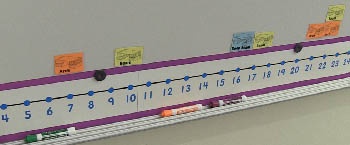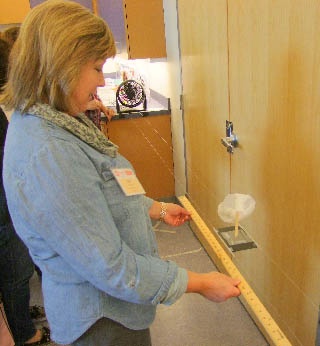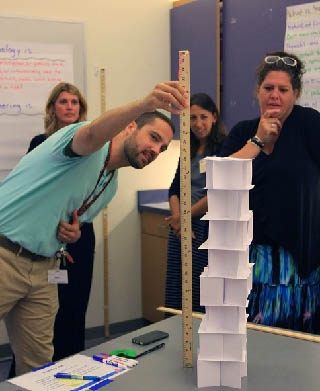 |
| Extend math learning with a line plot for “Designing Bridges” data. |
Making Math Matter
 |
| A teacher checks “distance sailed” at an EiE workshop. |
Consider the expectation that elementary students will learn to measure using a ruler. A typical lesson aimed at developing this skill is abstract: Students walk around the classroom measuring desks, chairs, and windowsills. But why does it matter?
Now consider Lesson 3 of the EiE unit Catching the Wind: Designing Windmills. Students design sails for a boat, measure how far it sails, work on improving their designs, then send the boat sailing again. Now measuring has a purpose—to see if the boat sails farther when you adjust the size or shape of the sail.
Math Practices Embedded in Every Unit
Every EiE unit can integrate with math instruction, but To Get to the Other Side: Designing Bridges works particularly well. Here's one math integration activity for upper elementary students included in the Guide.
In Lesson 4, students design and construct a bridge, then test how much weight it can support. As they plan their bridge, they make a chart showing the materials they will use (for example, index cards, soda straws), and how many pieces of each material. Challenge them to use their multiplication skills to calculate the total cost for each bridge component: for example, five soda straws at 50 cents per straw = $2.50.
That's just one example. The math practices embedded throughout this unit include:
- Making sense of problems and persevering in solving them
- Reasoning abstractly and quantitatively
- Constructing viable arguments and critiquing the reasoning of others
- Modeling with mathematics
- Using appropriate tools strategically
- Attending to precision
LEMSTEM Gives You MORE Math Activities
When you attend a LEMSTEM workshop, you'll learn about—and try!—many math extension lessons that go beyond the activities already in your Teacher Guide. Consider Lesson 3 of Bridges, where students construct arch, beam, and deep beam bridges from index cards and see which kind supports the most weight. Each team of students reports the number of weights that each of their three bridges supports; as the teacher, you collate the data on a chart.
LEMSTEM shows you how to extend this activity by having students represent their data with a line plot—a bold visual representation of data that boosts student understanding while also meeting Common Core Math expectations for line plots for grades 3–5.
What to Expect at Your Workshop
 |
| Does this tower meet the criteria “Display a statue at eye level?” |
At a LEMSTEM workshop, you'll spend two full days with a group of like-minded teachers (and our expert facilitators) working on hands-on activities that provide meaningful math/engineering integration. You'll work collaboratively to plan an integration strategy for your own classroom. And you'll leave with handy resources, like an integration table that lays out how the activities in certain EiE lessons map to Common Core Math Clusters, Practices, and Standards.
Our integration tables also include more extension lessons to enhance math learning. Here's one example: When students build bridges of their own design in Lesson 4, they record the number of items used to build their bridge (for example, 12 index cards, four soda straws). Challenge them to IMPROVE their designs while using fewer materials than the first design.
We're offering LEMSTEM workshops at our headquarters at the Museum of Science, Boston on April 7–8 and August 4–5, 2016. Reserve your spot today!
Engineering is Elementary is a project of the National Center for Technological Literacy at the Museum of Science, Boston.








